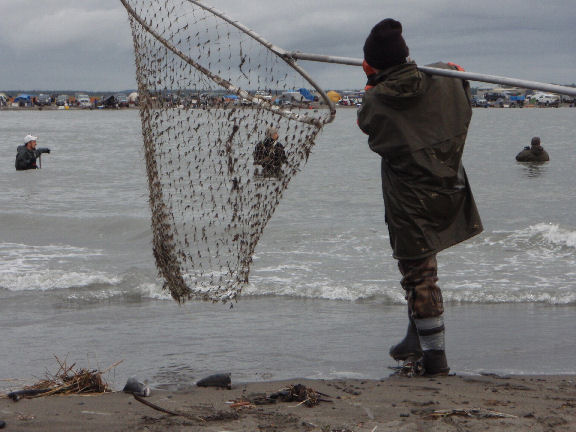We live in the land of salmon... bountiful runs of wild fish, free for the taking. If, that is, you are game for the adventure. Our annual meat fishing trips are each unique in their set of circumstances- and we almost always get our fish.
Salmon is a staple in our house. We set aside a two week block of time at the end of July to catch our limit. That's how we always celebrate our daughter's birth and our wedding anniversary. Usually we're allowed 45 fish, plus a 10-flounder bycatch. And generally we bring home a small freezer full of meat and carcasses.

Our chickens and goats and dogs all go wild for fish carcasses. You haven't lived until you've seen a goat fight a dog for a particularly fleshy morsel, or watched a yard of chickens pick a salmon backbone clean in a matter of seconds.
Often when we're dip netting, we bring the milk goat along. She wears a backpack and hauls freshly killed fish on her back for us. Otherwise, we have to pack them all ourselves... and that turns into alot of work. In fact, its alot of work no matter how you look at it.
Sometimes the weather is great and the fishing is slow. Other times its non-stop rain and wind and we catch our limit in a matter of hours. Its never predictable, often exhausting, and always worth our effort.
Only permanent Alaskans are allowed a dip net permit. Its called a personal use fishery. There are strict regulations in place to limit which parts of which rivers and beaches are open, and when. We use special nets stretched over a 5 foot diameter hoop, on a 12 foot long pole with a huge D-handle.
When fishing on the Kenai, its mostly done in the water wearing neoprene waders and insulated gloves- whether in the ocean waves or the river proper. When fishing on the Copper River, all fishing is done from the bank... generally roped in, lest you fall victim to the fast moving water.

Wherever you are, its a cold, wet, smelly job... and is sometimes more enjoyable than others. Of course, most of the work begins after the fish are pulled from the net. Just killing a fresh silver is a chore in itself. Then comes the gutting and skinning and boning, the canning or smoking or freezing.
But ya gotta love it, however it comes out. Salmon fishing and dipnetting in particular are basic to our lifestyle. One winter, I ate salmon everyday. Salmon and rice and cabbage, and occasionally some cheese and salsa.
Salmon patties, salmon salad, broiled salmon, baked salmon, barbecued salmon, salmon dip... you get the picture. Whole cookbooks are written just about storing and preparing our resident wild fish. Yep, a person can get tired of eating salmon day-in and day-out, but it sure fills the freezer and the belly well. Let's go fishin'!